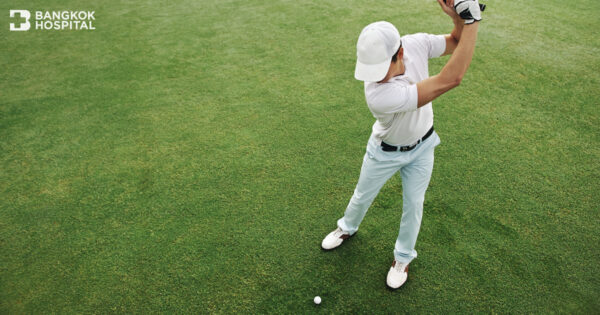Golf has seen a significant surge in popularity among all genders and age groups, both beginner and pro levels. Golf might look like an easy game to play, just to hit a stationary object with a club into a relatively wide open space. In fact, golf requires a lot of practice and effort as well as great skills and perseverance to excel at it.
Although golf is perceived as being a low-risk sport when it comes to injuries since direct contact is not required, many young golfers, especially those who lack proper technique, suffer from acute or overuse injuries. Since the explosive nature of the swing can put a tremendous amount of stress on the body, a majority of professional golfers have experienced injuries at one time or another in their careers. A number of factors have contributed to common golf swing injuries. Approximately 80 % of all reported golf injuries are caused by overuse or over-practice. The main causes of these injuries include lack of flexibility, poor conditioning, excessive play or practice, poor swing mechanics, ground impact forces and intermittent play. While another 20% of golf injuries are induced by traumatic force and accidents. Acute injuries are usually the result of a single, traumatic episode such as hitting the ground of a submerged tree root in a sand trap. Overuse injuries are more subtle and usually occur over time. These injuries will more often stem from the stress that the golfer puts on the back and shoulders when swinging. The three most commonly injured areas of the body are the back, shoulder and elbow. These conditions should be treated with rest, a good stretching/warm-up program and advanced technology in sport medicine.
The most common golf injuries
Collected data in golf injuries has indicated that a wide range of golf injuries can vary among individuals, depending on genders, age, skill and playing frequency. The most common golf injuries include:
1. Back pain
An estimated 30 percent of golfers will experience some form of low back pain, especially in the beginners. Injuries can range from back pain caused from overuse, muscle tear and spinal disc injuries. The rotational stresses of the swing can place considerable pressure on the spine and muscles. Compound that with the fact that golfers spend four to five hours in a bent-over stance, repeating the same motion hundreds of times, it is no wonder that playing golf can cause minor strains in the back that can easily lead to severe injuries. In elderly golfers, degenerative disc disease and fracture can also happen. Additionally, professional golfers tend to experience neck injuries.
2. Tendinitis in the elbows
Tendinitis is described as irritation and inflammation of the tendon tissue. This is the most common condition affecting the elbow. It is frequently referred to as “tennis elbow” when there is an injury to the outer tendon and “golfer’s elbow” when there is an injury to the inner tendon. Golfer’s elbow is mostly found in the right elbow of right-handed golfers who overuse or over-practice, resulting in chronic inflammation and severe pain. Tennis elbow is a painful condition that occurs when tendons in the elbow are overloaded, usually by repetitive motions of the wrist and arm. Tennis elbow is frequently found in the left elbow of right-handed golfers, specially in the beginners.
Interestingly, most golfers suffer more from “tennis elbow” than “golfer’s elbow.” The risk of getting tendinitis increases with age and its incidence is higher in people who routinely perform activities that require repetitive movements that increase stress on susceptible tendons such as hitting golf balls. In addition, these type of injuries can be aggravated by an improper swing motion. Treatment focuses on full resting the injured tendon to allow healing, decreasing inflammation and promoting muscle strength as well as improving improper swing mechanics. In most patients, tendinitis readily resolves with treatment.
Furthermore, the repetitive motions of golf and the high speed of the typical swing can place wrists at a high risk for injury. Pain and tenderness on the top of the wrist, experienced at the top of the backswing and at impact are common. The most common golf-related wrist injury is tendinitis or swelling of the tendons responsible for wrist movement.
3. Rotator cuff and shoulder
Pain may be felt in the shoulder or upper arm during various phases of the golf swing or after finishing the game, often during the night and when extending arms overhead. Injuries to the rotator cuff can be caused by traumatic force resulting from a poorly executed golf swing, hitting a root or rock, taking a deep divot and overuse. Repetitive motion of the golf swing can develop tendinitis, bursitis and tears in the rotator cuff. Elderly golfers have the greater chances to experience serious shoulder injuries due to advanced age and degeneration.
4. Knee injuries
Knee pain usually occurs from the strain placed on a weak knee to stabilize the rotation of the hip axis at the beginning of the swing. Left knee is usually affected in right-handed golfers and vice versa. Extreme force placed on the knee potentially results in torn ligaments. Wrong knee position also causes falling over. Arthritis sufferers may experience more knee problems because the degenerative nature of the disease, which results in a gradual wearing away of joint cartilage.
Certain factors largely contribute to different degree of knee pain e.g. golf course, holes, ground surface, weight and age of golfers. Risks to develop severe knee injuries e.g. ligament wear and tear are higher in elderly or obese golfers.
5. Foot and ankle injuries
Throughout the golf swing, power production starts with the feet pushing against the ground. During a golf swing, each foot moves differently. Foot and ankle injuries can occur when the golfers lose their footing or balance during the swing, while performing the swing with the improper swing mechanics, especially when hitting a ball off an uneven surface. Common foot and ankle injuries include sprains in the ankles, tendinitis in the ankle and foot bones and inflammation and blisters. Wearing properly fitted golf shoes and improving swing mechanics are the best ways to prevent foot and ankle injuries.
A wide range of golf injuries can happen during the games and practices, starting from mild injury e.g. muscle pain to chronic conditions. A number of factors that contribute to common golf swing injuries include overuse and over-practice, over-swinging, poor swing mechanics, lack of proper warming up, incorrect grip and setup as well as traumatic force to the body resulting from a poorly executed swing.
Particularly in the beginners, injuries are mostly caused by improper swinging, incorrect grip and set up, excessive forces generated from the arms and shoulders and imbalance of the body. Interestingly, up to 80% of professional golfers have been injured due to overuse or over-practice. While another 20% of golf injuries are induced by traumatic force and accidents. Acute injuries are usually the result of a single, traumatic episode, such as hitting the ground of a submerged tree root in a sand trap. Overuse injuries are more subtle and usually occur over time.
Pain that needs medical assistance
The three most commonly injured areas of the body are the back, shoulder and elbow. These conditions should be treated with rest, a good stretching/warm-up program and advanced technology in sport medicine. In case of mild pain, cold compression is primarily advised with resting and taking anti-inflammatory medicines. After taking a full rest and medicines, if pain progresses e.g. back pain that radiates to the legs, numbness, chronic elbow or shoulder pain, arm weakness, swelling knee or serious accidents, medical advices provided by expert sport medicine doctors must be sought as soon as possible.
Treatment of golf injuries
Selected treatment entirely depends on type of injuries, severity and related signs and symptoms. If the muscles are inflamed, recommended treatments include taking rest of that affected areas to avoid using the injured muscles and applying cold compression. If pain get worse and progresses, additional treatments might be needed e.g. therapeutic ultrasound, laser and shockwave therapy.
In serious cases such as ligament tear, injured joint or spinal disc dislocation, additional imaging tests are required for further investigation e.g. MRI. Initial treatment consists of resting, splinting and anti-inflammatory medications, both oral forms and injections accompanied with rehabilitation program. If symptom severely progresses without improvement, resulting in impaired quality of life, surgical approach might be considered.
Prevention of golf injuries
There are several different ways to reduce the chances of golf injuries while golfing. Proper warm up and stretching is important. It is highly recommended to gradually increase the length and intensity of play as the season progresses can help avoid overuse injuries. Conditioning and core muscle strengthening e.g. in the back and abdomen (by planking) can also improve swing mechanics and minimize chance of having back pain. Instruction with a teaching professional helps to refine technique and increase enjoyment of the game injury free.
In addition, preventing the most common golf injuries can be done by working on improving swing mechanics, participating in golf-specific conditioning programs, buying properly fitted equipment e.g. light-weight equipment and avoiding long practice sessions. In addition, eating 5 food groups and drinking sufficient water are essentially suggested.
In order to get fit before golfing, golfers should be tested for their physical fitness and muscle functions. Not only to evaluate the fitness level of the muscles and entire body, Fit for Play Program also helps to reduce chances of injuries that possibly happen during the games. This program is recommended for general players, elderly ones and frequent golfers. In addition, Fit for Performance Program is advanced test to assess physical fitness for professional golfers before entering the competitions, resulting in enhanced confidence throughout the games.











